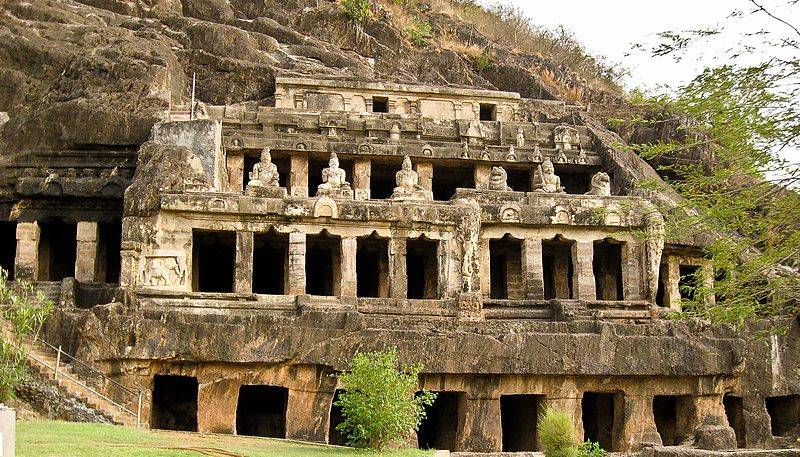The Undavalli Caves, carved out of sandstone on a hillside, are a splendid example of Indian rock-cut architecture. Located in the state of Andhra Pradesh, these caves date back to the 4th to 5th centuries AD. They are renowned for their large sculptures and intricate carvings that depict various deities and scenes from Hindu mythology. The caves are a testament to the skills of ancient Indian artisans and hold significant historical, cultural, and architectural value.
Vishnukundina Dynasty
The Vishnukundina Dynasty, flourishing from the 4th to the 7th century AD, was a significant power in the Deccan and South India. Originating from the Godavari River basin, this dynasty played a pivotal role in the cultural and political landscape of ancient India. Their reign is marked by a blend of martial prowess and patronage of the arts, contributing to the rich tapestry of Indian history.
The dynasty’s timeline is characterized by expansion and consolidation of territories, with their influence extending over parts of present-day Andhra Pradesh, Telangana, and Odisha. The Vishnukundinas were instrumental in bridging the gap between the decline of the Satavahana Empire and the rise of the Vakataka and Pallava powers, thus maintaining the continuity of Indian civilization during a period of potential fragmentation.
Religion under the Vishnukundina Dynasty was predominantly Hindu, with a strong emphasis on Vaishnavism. The rulers were devout followers of Lord Vishnu, which is reflected in their name – ‘Vishnukundina’ literally translates to ‘the staff of Vishnu’. This devotion also influenced their patronage, leading to the construction of several temples dedicated to Vishnu and his avatars. However, they were also tolerant of other religious practices, including Buddhism and Jainism, which continued to flourish in their territories.
The social and daily life during the Vishnukundina period was marked by a hierarchical structure, typical of ancient Indian societies. The caste system played a significant role in determining one’s occupation and social status. Agriculture was the backbone of the economy, supported by trade and crafts. Literature, art, and architecture saw significant development under their rule, with the dynasty contributing to the growth of Telugu and Sanskrit literature.
Notable rulers of the Vishnukundina Dynasty include Madhavavarman I and Govindavarman, who are celebrated for their military campaigns and efforts in consolidating the dynasty’s power. Their reigns were marked by battles against neighboring kingdoms and efforts to fend off invasions, showcasing their strategic and military capabilities.
The dynasty did not have prominent queens who wielded political power, but royal women were patrons of religion and the arts. They played a significant role in the social and cultural life of the dynasty, contributing to its legacy.
The Vishnukundina Dynasty’s decline began in the 7th century AD, as they faced challenges from the growing powers of the Chalukyas and Pallavas. Despite their eventual fall, the dynasty left an indelible mark on the region’s history, particularly in the realms of religion, culture, and governance.
Their legacy is evident in the architectural and literary contributions that continue to be celebrated in Indian history. The Vishnukundina Dynasty, with its rich cultural heritage and significant political achievements, remains a testament to the dynamism of ancient Indian civilization.

